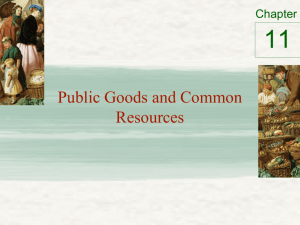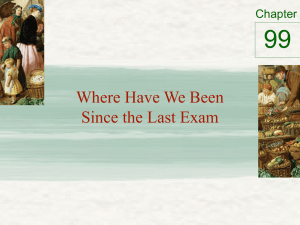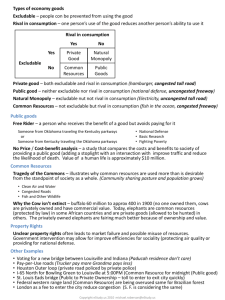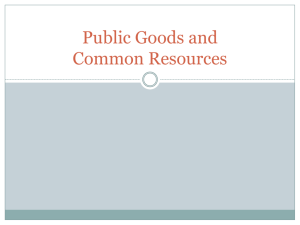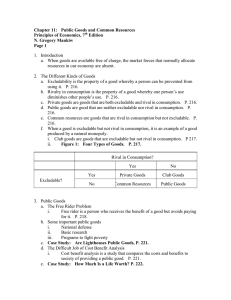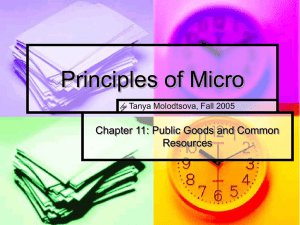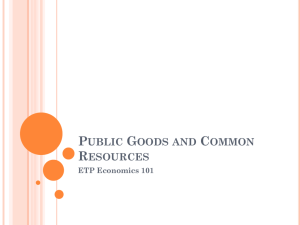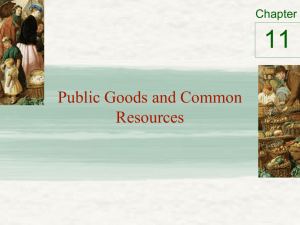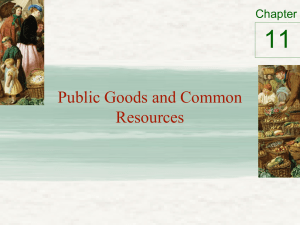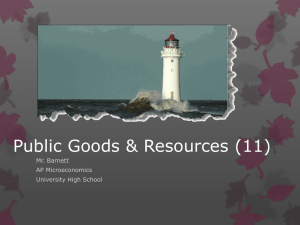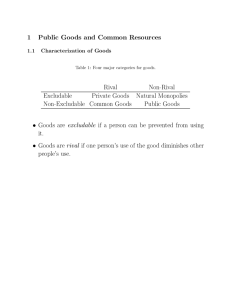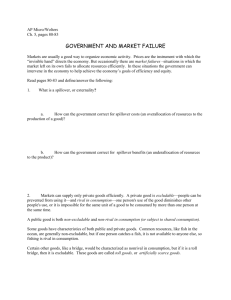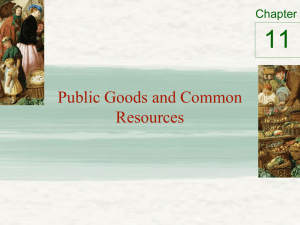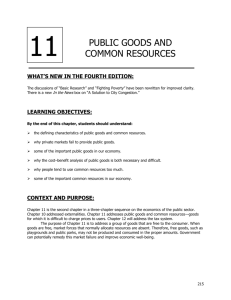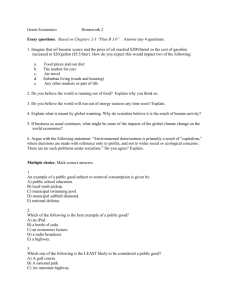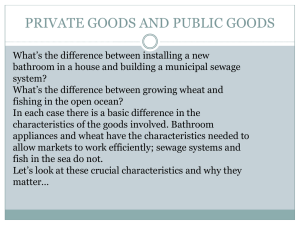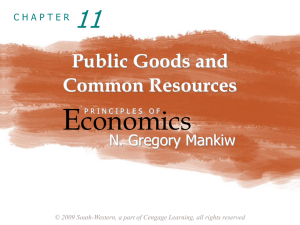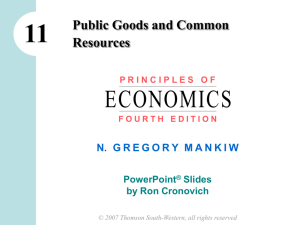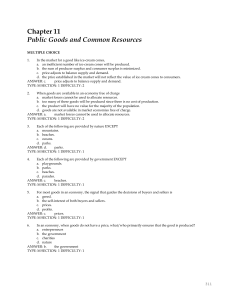Public Goods - (powerpoint only)
advertisement
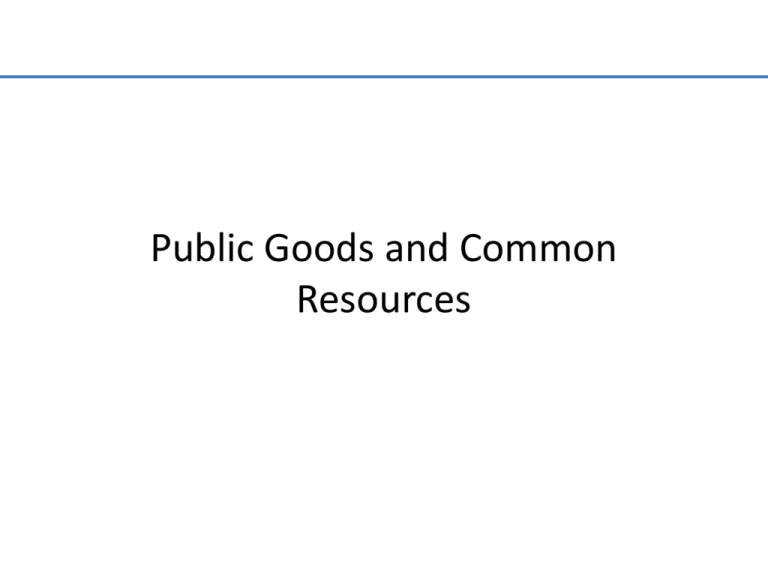
Public Goods and Common Resources Four types of goods Goods can be grouped into four categories according to two properties: • Excludable – people can be prevented from using it. • Rival in consumption – one person’s use of the good diminishes other people’s use of it Rival in consumption? Yes Excludable? Private goods Yes No Natural monopolies - Ice-cream cones - Clothing - Congested toll roads - Fire protection - Cable TV - Uncongested toll roads Common resources Public goods No - Fish in the ocean - The environment - Congested nontoll roads - Tornado system - National defense - Uncongested nontoll roads Different Kinds of Goods Types of goods – Private goods • Excludable & Rival in consumption – Public goods • Not excludable & Not rival in consumption – Common resources • Rival in consumption & Not excludable – Natural monopoly • Excludable & Not rival in consumption Different Kinds of Goods Public goods & Common resources – Not excludable – People cannot be prevented from using them – No price attached to it – Positive externalities – Negative externalities Public Goods The free-rider problem – Free rider: A person who receives the benefit of a good but avoids paying for it – Public goods are not excludable • Free-rider problem prevents the private market from supplying the goods • Government can remedy the problem If total benefits of a public good > its costs – Provide the public good – Pay for it with tax revenue – Make everyone better off Public Goods Some important public goods – National defense • Very expensive public good – Basic research • General knowledge – Fighting poverty • Welfare system • Food stamps Are lighthouses public goods? • Lighthouses mark specific locations so that passing ships can avoid treacherous waters • Benefit to the ship captain: – Not excludable, not rival in consumption • Incentive to free ride without paying – Most are operated by the government • In some cases – Lighthouses are closer to private goods • Coast of England, 19th century – Lighthouses ware privately owned and operated – The ship charged by the owner of the lighthouse Are lighthouses public goods? • Decide whether something is a public good – Determine the beneficiaries – Determine whether the beneficiaries can be excluded from using the good • A free-rider problem – When the number of beneficiaries is large – Exclusion of any one of them is impossible Public Goods Public Good, with no price, require a cost– benefit analysis – Government • Decide what public goods to provide • In what quantities – Cost–benefit analysis • Compare the costs and benefits to society of providing a public good without any price signals to observe • Government findings on the costs and benefits – Rough approximations at best How much is a life worth? Adding a traffic light to reduce the lose of life • Cost: $10,000 for a new traffic light • Benefit: increased safety – Risk of a fatal traffic accident • Drops from 1.6% to 1.1 % • Obstacle: To measure costs and benefits in the same units • Must put a dollar value on a human life How much is a life worth? • Putting a dollar value on a human life – Implicit dollar value • Courts award damages in wrongful-death suits – Ignores other opportunity costs of losing one’s life • Risks people are voluntarily willing to take • Value of human life equals approximately $10 million • Cost-benefit analysis • A Traffic light reduces risk of fatality by 0.5 percentage points (1.6% to 1.1 %) • Expected benefit = 0.005 × $10 million = $50,000 • Cost ($10,000) < Benefit ($50,000) • Approve the traffic light Common Resources • Not excludable • Rival in consumption • The tragedy of the commons – Parable: why common resources are used more than desirable from society’s standpoint – Social and private incentives differ – Arises because of a negative externality Common Resources The tragedy of the commons – Negative externality • One person uses a common resource and diminishes other people’s enjoyment of it • Common resources tend to be used excessively – Government can solve the problem • Regulation or taxes to deduce consumption of the common resource • Turn the common resource into a private good Common Resources Some important common resources – Clean air and water – Congested roads – Fish, whales, and other wildlife Common Resource: Animal Species Species of animals with commercial value are threatened with extinction – Buffalo in North America in 19th century • Common Resource • Over hunted to near extinction – The European cow in North America • Private Good • Species continues to thrive Common Resource: Animal Species • Elephants as a common resource in Africa – No owners – Poachers are numerous • Strong financial incentive to kill them • Slight incentive to preserve them • Cows are private good – Ranches: privately own cow (protected by law) – Ranchers • Great effort to maintain the cattle population on his ranch • Reaps the benefit of commercial value Why the cow is not extinct Government intervention to help the elephant – Elephants are common resource in Kenya, Tanzania, and Uganda • Illegal to kill elephants; Illegal to sell ivory • Hard to enforce • Elephant population continues to diminish – Elephants are private goods in Botswana, Malawi, Namibia, and Zimbabwe • People are allow to hunt elephants • Landowners have an incentive to preserve elephants • Elephant population – started to rise
